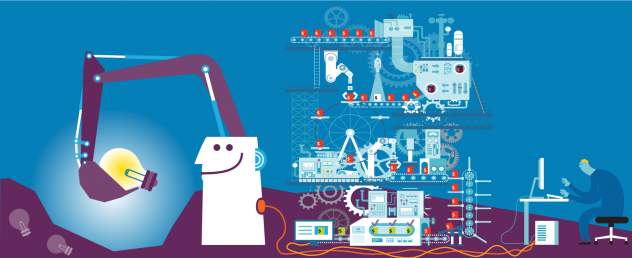Connected Machines Work Harder
Significant productivity improvement, combined with improved data accuracy and positive cultural change are all outcomes of connecting mining machines to processes, monitoring and reporting more broadly across business systems. This is one of the key roles for the IoT (Internet of Things) in mining.

Continuous miners used in underground coal mining gather data from over 300 sensors on each machine, with each sensor capturing and transmitting data every second… that’s a lot of data!
The downside of having all this data available is that much of it is only looked at daily, at best, mostly in the form of OEM (Original Equipment Manufacturer) reports, and usually there is no linkage to other operational reporting… you are seeing only the performance figures for the individual machine. Moreover, OEM reports from the machinery are not easily changed and often do not match business requirements. Therefore, they are looked at in isolation to other pertinent data (shift information, production targets, budget, etc.), and there is little chance of any meaningful ‘bigger picture’ insights being gained.
Moving beyond the limits of the OEM reports, connectivity via IoT now means that this data can be collated and analysed, combined with data from other relevant sources, and presented either on a mobile device or emailed to stakeholders in accordance with a pre-determined schedule.
This is exactly the sort of approach Pulse Mining Systems is taking by developing integrated software and analytics products which have specific application right across mine operations. For instance, one of our analytics apps (Production Analytics) draws data from continuous miners, shift schedules and the Pulse Mining ERP to paint a bigger picture and help facilitate improved productivity.
A related problem has been inaccuracy of data collected through manual entry practices. Mining production data has often been manually entered to systems from reports that were written by the operational process supervisors. These reports were not always accurate because they were written by personnel who had a vested interest in reporting positive results for their team… basically they were filling out their own report card. Data entry constraints also meant that the manually entered data was not available for review on cycles of less than 24 hours and hence did not fit with common business requirements, such as to review the process prior to leaving the site at the end of the shift.
Amongst the many benefits of implementing a solution such as Pulse Mining’s Production Analytics app reported by our clients, one which stands out is that when using mining machinery such as continuous miners, the use of automatic mode versus manual mode is always desired by mine management since it delivers consistent results and minimises risk of damage to equipment and injury to personnel. However, for cultural reasons operators tend to operate the equipment in manual mode. As the app now routinely reports the mode which the operator uses, the use of automatic mode has increased significantly across many of the sites and processes… all with little conspicuous pressure from management.
In the case of one of our clients, several apps have been implemented as part of a larger step change program being run by the company which is striving to understand and utilise their production processes to their greatest efficiency. The solution has been configured to fit within the normal operational parameters of their mine sites, for instance to match traditional meeting times (for reporting of shift results, etc.), and as such minimal operational change has been required. The client has reported that working with the solution has increased the understanding of front-line managers on how the people and equipment perform within the overall mining process, and an increase in reporting accuracy has been noted due to automatic data inputs replacing much of the old manual reporting process.
In terms of using our solutions in other mining situations… the fundamental elements are now all in place, it is only a matter of configuring the base application to suit differing machinery types and configurations, as we have already done in several instances. The Continuous Miners are probably amongst the most complex and data-intensive mining equipment currently in use underground, therefore adaption of our app to suit simpler drilling rigs is a relatively quick and easy undertaking. Pulse Mining is currently working with several small-to-medium sized mining companies to both customise our Operational Mining Analytics Apps for their use, and in some cases to develop solutions specific to their needs. As the apps are built on a framework that allows us to ‘plug-in’ rapid development and prototyping using Agile and Lean development methodologies we can deliver customised apps quickly and at a very affordable price-point.
So… what does this all mean in terms of productivity?
One client has reported the following productivity increases due to the use of Pulse Mining’s Production Analytics app:
- Continuous Miner operating rate has increased by 3.2%
- Tonnes produced has increased by 2.77%
These sort of productivity increases can translate to an increase in mine production valued at between $2.5 million and $3 million per annum.
Significant productivity improvement, combined with improved data accuracy and positive cultural change… all this from implementing only one of Pulse Mining’s suite of operationally-focused, IoT-enabled, mining-specific analytics apps!

